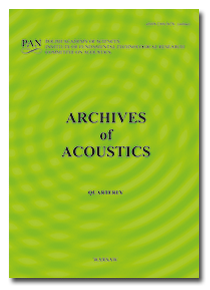Archives of Acoustics,
38, 3, pp. 297–301, 2013
Investigation of Ultrasonic Emulsifying Processes of a Linseed Oil and Water Mixture
Ultrasonic emulsifying processes of immiscible liquids can be used to obtain stable emulsions. The authors used an ultrasonic sandwich head with an energy concentrator to obtain a suitable value of the energy density necessary for the emerge of ultrasonic cavitation. Two piezoelectric ring (Dext = 50 mm) transducers of Pz-26 type produced by FERROPERM were used to design the ultrasonic sandwich head. The frequency of the ultrasonic wave was 18.4 kHz and the excitation time of the ultrasonic transducer exiting 5 minutes. Visible bubbles during the generation of ultrasonic waves appeared in the mixture after exceeding the cavitation threshold. The authors determined also the cavitation threshold by measuring the electrical voltage conducted to the transducers. To receive long-lasting emulsion, the electrical voltage attained 300 Vpeak. The dispersion dependence on the emulsifying time was determined. The emulsion of linseed oil and water was stable through some months without surfactants.
Keywords:
ultrasonic cavitation; ultrasonic emulsifying processes; emulsion; cavitation threshold
Full Text:
PDF
Copyright © Polish Academy of Sciences & Institute of Fundamental Technological Research (IPPT PAN).





